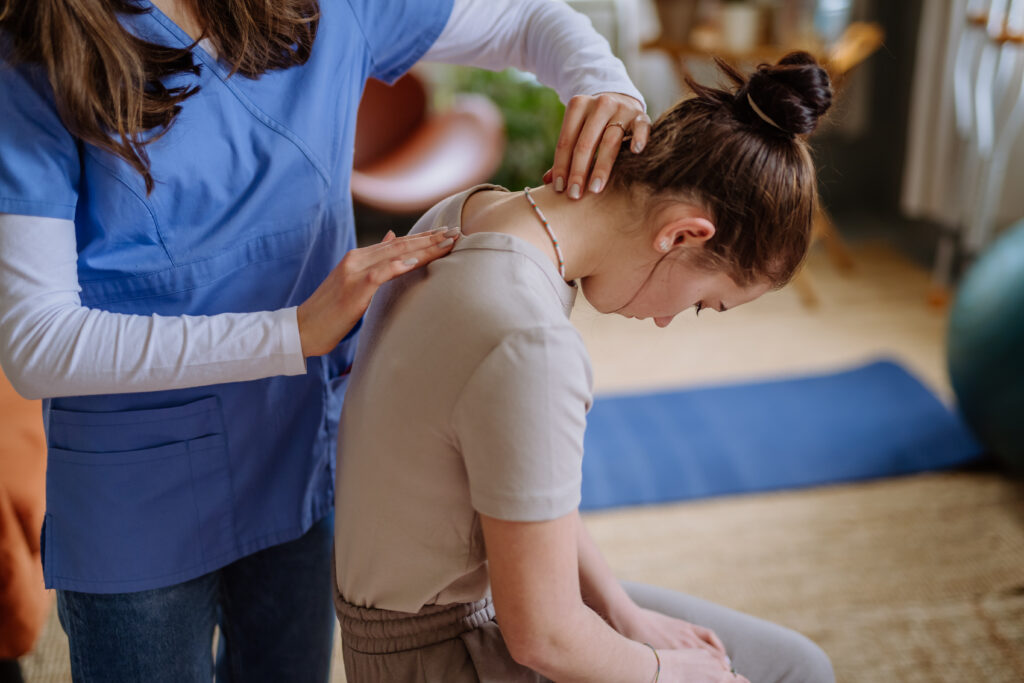A detailed presentation on conservative (non drug, non surgical) options for adolescent scoliosis. Pain relief, postural correction, stopping progression and reversing the curvature and preventing the use of bracing or surgical intervention. Specific Scoliosis Exercise programs are described combined with targeted stretching, active self correction and neuro muscular re-education techniques. The latest research in scoliosis bracing. There is hope for parents with children diagnosed with scoliosis!
Non-Surgical Care for Adolescent Scoliosis
Adolescent scoliosis is a common spinal condition that affects many young individuals during their growth spurt. While surgical intervention is sometimes necessary for severe cases, non-surgical care options have proven to be effective in managing and treating this condition. In this article, we will explore the insights gained from a discussion on non-surgical care for adolescent scoliosis, focusing on the importance of early detection, the role of physical therapy, and the benefits of bracing.
Early Detection
Key to Successful Management Early detection plays a crucial role in effectively managing adolescent scoliosis. Detecting the condition during the early stages allows for timely intervention and better outcomes. It was emphasized that regular screenings in schools and healthcare settings can significantly contribute to early detection. Implementing comprehensive scoliosis screening programs and educating parents, teachers, and healthcare professionals about the signs and symptoms of scoliosis can ensure timely referrals for further evaluation.
The Role of Physical Therapy in Adolescent Scoliosis
Physical therapy plays a vital role in the non-surgical management of adolescent scoliosis. The significance of exercise and therapeutic techniques in improving postural alignment, reducing pain, and preventing the progression of scoliotic curves is very big. Here are some key aspects of physical therapy for adolescent scoliosis:
- Individualized Exercise Programs: Physical therapists develop personalized exercise programs tailored to the unique needs of each patient. These programs typically focus on strengthening the muscles surrounding the spine, improving flexibility, and enhancing overall postural stability. Regular exercises help to maintain spinal alignment and slow down curve progression.
- Core Strengthening: Strengthening the core muscles is essential for individuals with scoliosis. Specific exercises targeting the deep abdominal muscles and back extensors can help stabilize the spine and promote better posture. The effectiveness of core strengthening exercises and their role in preventing muscle imbalances and asymmetries is very big.
- Manual Therapy Techniques: Physical therapists may employ various manual therapy techniques to alleviate pain and improve mobility in individuals with scoliosis. Techniques such as soft tissue mobilization, joint mobilization, and myofascial release can help reduce muscle tension, improve spinal mobility, and enhance overall function.
Bracing as a Non-Surgical Treatment Option
The benefits of bracing as a non-surgical treatment option for adolescent scoliosis. Bracing aims to halt or slow down the progression of spinal curvature during the rapid growth phase of adolescence. Here are some key points regarding bracing:
- Types of Braces: Several types of braces are available, including the Boston brace, Charleston bending brace, and the Milwaukee brace. Each brace is custom-fitted to the individual’s unique spinal curvature and is worn for a specific number of hours per day. Also there is a huge importance of consistent brace wear to maximize its effectiveness.
- Compliance and Psychological Support: Wearing a brace can be challenging, both physically and emotionally, for adolescents. Providing adequate psychological support and educating patients and their families about the importance of brace compliance are crucial. Also the significance of peer support groups, counseling, and regular follow-up visits to ensure patient adherence to the bracing regimen is very big.
Conclusion
Non-surgical care options, including early detection, physical therapy, and bracing, offer promising solutions for managing adolescent scoliosis. By implementing comprehensive screening programs, individualized exercise plans, and custom-fitted braces, healthcare professionals can improve outcomes, reduce curve progression, and enhance the overall quality of life for young individuals with scoliosis. Early intervention and a multidisciplinary approach remain key to successful non-surgical management of adolescent scoliosis.
Also read: Non-Surgical Scoliosis Treatment – The Strauss Method
About:
Dr. Strauss is the director of the Hudson Valley Scoliosis Correction Center in New York. He has been actively engaged in scoliosis treatment for the past 30 years and has authored two books on the subject, Your Child Has Scoliosis and The Truth About Adult Scoliosis.
He is Vice President of the CLEAR Scoliosis Institute and a lecturer for their introductory and advanced workshops. He is certified in scoliosis bracing and in the use of scoliosis specific exercises. Dr. Strauss is a graduate of the ISICO World Masters of Scoliosis.His postgraduate studies also include a Masters Degree in Acupuncture as well as training in Grostic, Pettibon, CBP, Clinical Nutrition, Chinese Herbal Medicine, Manipulation under Anesthesia, and Electrodiagnosis.
His scoliosis practice has treated patients from 25 states and 32 other foreign countries.
If you have questions about childhood and adult scoliosis and how it can be successfully treated without surgery subscribe to our channel!
